The old barn (100+ yrs) we built the coop in. it was the old tack room The coop is in the room behind the open door. I promise all the crap has been picked up and stored!!!

Nest boxes and the nipple water bucket we use. the garden hose fills it with the flip of a switch.

Water storage tank in the next stall. Built of 2" foam insulation surrounded by 7/16" OSB to slow the mice down. Inside is a submersable pump and stock tank heater. The pump is hooked to a standard light switch. It's very cold here in the winter and I did not want my wife to have to carry buckets of water to fill the waterer. We got the rigid foam insulation from the lumber yard. The were 'damaged' so they were only $5 each. The damage was a nick or scratch on thepanel, no big deal really. The hose going up, fills the bucket, in this picture I am fillng up the tank with a hose from the well. The extension chord is for the pump, I have since added an outlet for the tank heater.

This is a picture of the dunce caps we made out of left over metal fabric and shrink wrap. They keep debris out of the water and food, and the angle discourages the hens from jumping on them. You can also see the tree branches we cut from the pasture for our roosts. They look kinda cool we think. You can also see the fill hose for the bucket. I tied the bird bath deicer chord to the hose to keep it out of the way. The hose and chord are not attached to the bucket so we can take the bucket out to cleen it, or change it out with the spare. You can also see the hardware fabric light protectors I made to protect the lights from getting hit. They work, I have hit them numerous times with my mellon and have yet to break a bulb. Just make sure to put the finished end of the hardware fabric down so there are no sharpe edges. Don't want to admit how I learned that.

We decided to go with a sliding door to save space. In the day it covers the nest box access doors so the hens don't knock them open. At night it is held closed with a pvc rod, which also holds the nest box access door closed so vermin can't get in and the chickens don't get out. It sets just above the top hinge in the nest box access door. You can see the light protectors a little better here.

The door on the nest box provides a nice shelf to set a basket on while collecting eggs. In this picture you can see why we went with a sliding door. If the door swung open, there would be no room. We hung the door with a pocket door kit. The shutters were from an old cabinet hanging in the tack room. I just cut the face frame from the cabinet and screwed it to the door. The screen is embeded between the two OSB panels so it can not be pulled out, not easilly anyway.

Cold Weather:
I have stated before that when I start to feel concerned about the cold, and it is COLD here -30f to -40f, I think about pheasants and other wild birds living outside, with no abundance of food, ice or snow for water, sleeping in trees, etc and they are very healthy vibrant birds. Running around when it is -30 and windy as all get out. Why/How is that? Essentially they are the same as chickens. There are pheasant in Louisiana, and California, South Dakota, Wyoming, Canada, etc, etc. All the same breed, but they live in very different climates. God has given them the ability to produce feathers based on the conditions they are in. Where it is cold, more down, where it is hot, less. So in essence all you can do is mess up what God has already provided them by altering their surroundings and adding heat.
Raising chicks:
We had our chicks outside in three days in the grass, rocks and dirt. No medicated feed. We raised them dirty, introduced them to bacteria immediately. They were outside well into the night when it was 50* with no heat lamps, just a blanket over the top and one side to block the wind. After a week they were outside all night. We wrapped the kennel with a blanket to stop predators, or at least slow them down. They were in the coop at 2 weeks.
Water:
We have clean water available of course, do we use bleach, sterilize the coop, disinfect the water buckets? Absolutely not. Are they clean, Yes, we brush them out everytime we swap them, and if they get a bit slimy. But "will dirty water hurt my chickens" was the question. Here is my answer. No it wont hurt them. They like it better because it has the smell and taste of nature, what some call filth and disgust. There are bacteria, algae, and a host of other things in the water that the birds need for their digestive tract, overall health, and nutrition in that water that takes time, sunlight, fresh air and a little poo to grow. There is a reason for all that bacteria out there, rather than battle constantly agains it, we choose to embrace it.
Just my opinion though.
Raise your chickens tough, and they will be healthy, vibrant and adaptable. Pamper and cuddle them and they will be weak and prone to disease. Chickens are dinasoars, they got here by adapting to their environment, and they do it very well.
Checking your ventilation:
This is kinda strange, and I didn't really plan to test this way, it just kinda happened. We had a huge fly outbreak from one of those stupid fly catcher bags, so I got my compressor and drywall texture gun, and sprayed DE inside the coop and all over the inside of the barn. Our coop is actually built in the old tack room, with pine trunks as supports. We put the OSB right up to the trunks as close as we could. All the other walls are somewhat square but to stop intrusion I placed a piece of OSB at a 45* angle in all the corners. So the the coop is somewhat tight but has an envelope of fresh air around it. Anyway, While spraying the DE, I did not want it to go everywhere, so I closed up the window, door and shutters.
After walking out, it looked like the coop was on fire, except with white smoke coming out of all the corners where the coop is, and from under the roof. There was little if any breeze that day also. So by accident I was able to see that in fact there was active ventilation in the coop, that was basically caused by thermal convection.
Update on the ventilation: So come winter we started getting the dredded ammonia smell in our coop. Basically we figured in the summer the warm air caused thermal convection which all but stopped in the winter cold. So we had to cut some additional holes to get better ventilation. So the lesson learned is check your ventilation in the winter as well, the conditions are different so the ventilation will change also.
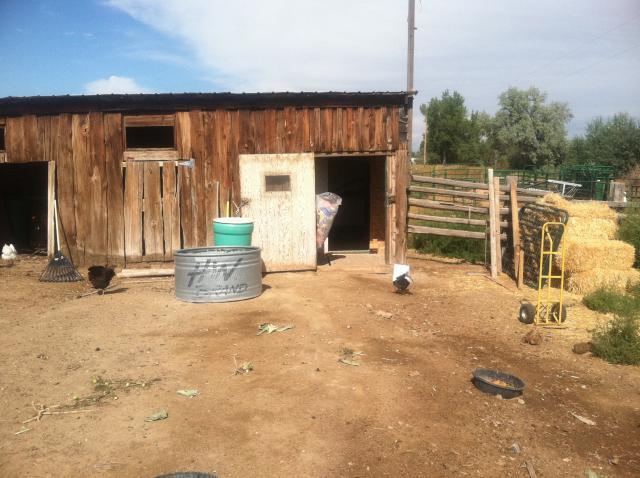
Nest boxes and the nipple water bucket we use. the garden hose fills it with the flip of a switch.
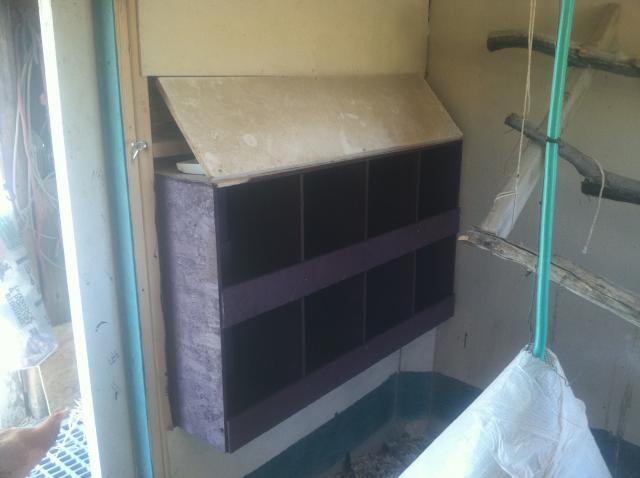
Water storage tank in the next stall. Built of 2" foam insulation surrounded by 7/16" OSB to slow the mice down. Inside is a submersable pump and stock tank heater. The pump is hooked to a standard light switch. It's very cold here in the winter and I did not want my wife to have to carry buckets of water to fill the waterer. We got the rigid foam insulation from the lumber yard. The were 'damaged' so they were only $5 each. The damage was a nick or scratch on thepanel, no big deal really. The hose going up, fills the bucket, in this picture I am fillng up the tank with a hose from the well. The extension chord is for the pump, I have since added an outlet for the tank heater.
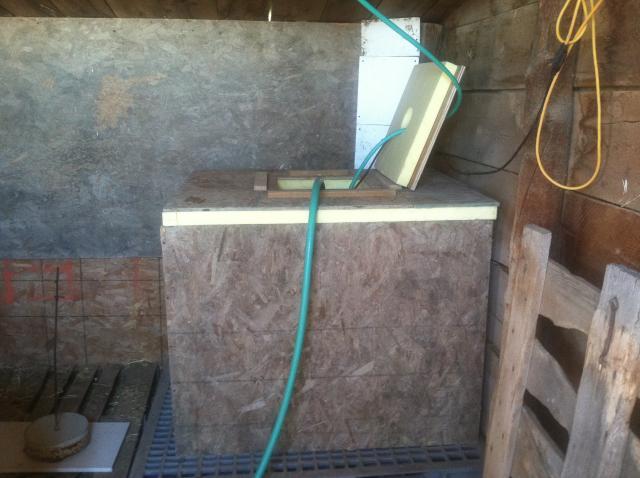
This is a picture of the dunce caps we made out of left over metal fabric and shrink wrap. They keep debris out of the water and food, and the angle discourages the hens from jumping on them. You can also see the tree branches we cut from the pasture for our roosts. They look kinda cool we think. You can also see the fill hose for the bucket. I tied the bird bath deicer chord to the hose to keep it out of the way. The hose and chord are not attached to the bucket so we can take the bucket out to cleen it, or change it out with the spare. You can also see the hardware fabric light protectors I made to protect the lights from getting hit. They work, I have hit them numerous times with my mellon and have yet to break a bulb. Just make sure to put the finished end of the hardware fabric down so there are no sharpe edges. Don't want to admit how I learned that.
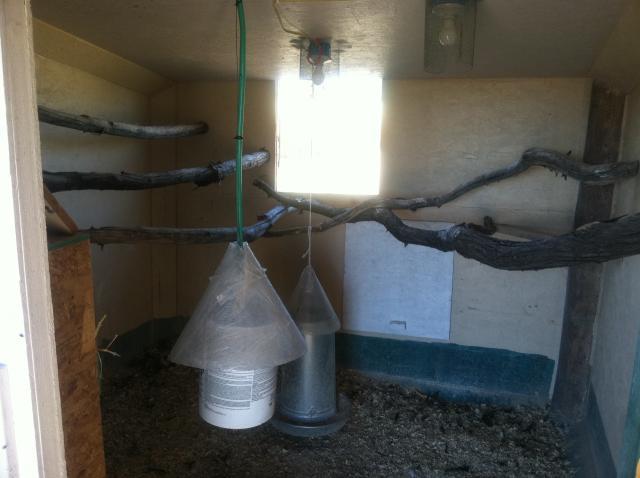
We decided to go with a sliding door to save space. In the day it covers the nest box access doors so the hens don't knock them open. At night it is held closed with a pvc rod, which also holds the nest box access door closed so vermin can't get in and the chickens don't get out. It sets just above the top hinge in the nest box access door. You can see the light protectors a little better here.
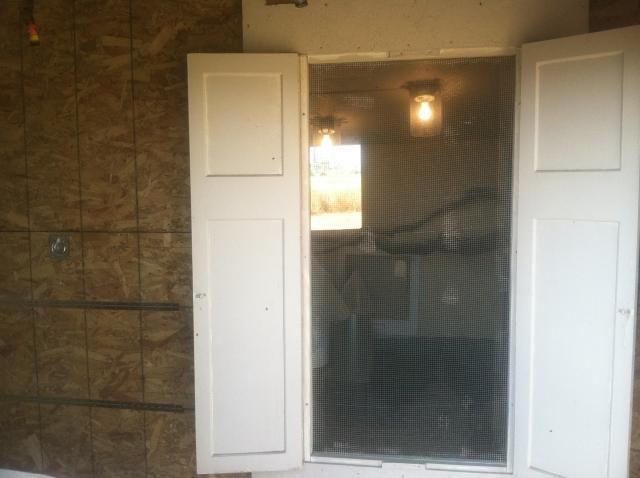
The door on the nest box provides a nice shelf to set a basket on while collecting eggs. In this picture you can see why we went with a sliding door. If the door swung open, there would be no room. We hung the door with a pocket door kit. The shutters were from an old cabinet hanging in the tack room. I just cut the face frame from the cabinet and screwed it to the door. The screen is embeded between the two OSB panels so it can not be pulled out, not easilly anyway.

Cold Weather:
I have stated before that when I start to feel concerned about the cold, and it is COLD here -30f to -40f, I think about pheasants and other wild birds living outside, with no abundance of food, ice or snow for water, sleeping in trees, etc and they are very healthy vibrant birds. Running around when it is -30 and windy as all get out. Why/How is that? Essentially they are the same as chickens. There are pheasant in Louisiana, and California, South Dakota, Wyoming, Canada, etc, etc. All the same breed, but they live in very different climates. God has given them the ability to produce feathers based on the conditions they are in. Where it is cold, more down, where it is hot, less. So in essence all you can do is mess up what God has already provided them by altering their surroundings and adding heat.
Raising chicks:
We had our chicks outside in three days in the grass, rocks and dirt. No medicated feed. We raised them dirty, introduced them to bacteria immediately. They were outside well into the night when it was 50* with no heat lamps, just a blanket over the top and one side to block the wind. After a week they were outside all night. We wrapped the kennel with a blanket to stop predators, or at least slow them down. They were in the coop at 2 weeks.
Water:
We have clean water available of course, do we use bleach, sterilize the coop, disinfect the water buckets? Absolutely not. Are they clean, Yes, we brush them out everytime we swap them, and if they get a bit slimy. But "will dirty water hurt my chickens" was the question. Here is my answer. No it wont hurt them. They like it better because it has the smell and taste of nature, what some call filth and disgust. There are bacteria, algae, and a host of other things in the water that the birds need for their digestive tract, overall health, and nutrition in that water that takes time, sunlight, fresh air and a little poo to grow. There is a reason for all that bacteria out there, rather than battle constantly agains it, we choose to embrace it.
Just my opinion though.
Raise your chickens tough, and they will be healthy, vibrant and adaptable. Pamper and cuddle them and they will be weak and prone to disease. Chickens are dinasoars, they got here by adapting to their environment, and they do it very well.
Checking your ventilation:
This is kinda strange, and I didn't really plan to test this way, it just kinda happened. We had a huge fly outbreak from one of those stupid fly catcher bags, so I got my compressor and drywall texture gun, and sprayed DE inside the coop and all over the inside of the barn. Our coop is actually built in the old tack room, with pine trunks as supports. We put the OSB right up to the trunks as close as we could. All the other walls are somewhat square but to stop intrusion I placed a piece of OSB at a 45* angle in all the corners. So the the coop is somewhat tight but has an envelope of fresh air around it. Anyway, While spraying the DE, I did not want it to go everywhere, so I closed up the window, door and shutters.
After walking out, it looked like the coop was on fire, except with white smoke coming out of all the corners where the coop is, and from under the roof. There was little if any breeze that day also. So by accident I was able to see that in fact there was active ventilation in the coop, that was basically caused by thermal convection.
Update on the ventilation: So come winter we started getting the dredded ammonia smell in our coop. Basically we figured in the summer the warm air caused thermal convection which all but stopped in the winter cold. So we had to cut some additional holes to get better ventilation. So the lesson learned is check your ventilation in the winter as well, the conditions are different so the ventilation will change also.
